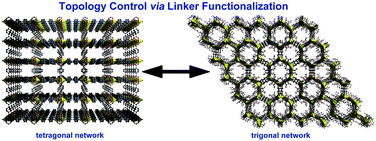Substitution of 1,4-benzenedicarboxylate (bdc) with additional alkoxy chains is the key to construct a family of metal–organic frameworks (MOFs) of the type [Zn2(fu-bdc)2(bipy)]n (fu-bdc = functionalized bdc; bipy = 4,4′-bipyridine) exhibiting a honeycomb-like topology instead of the default pillared square-grid topology. Both the substitution pattern of the phenyl ring of the fu-bdc linker and the chain length of the alkoxy substituents have a major impact on the structure of the derived frameworks. Substitution at positions 2 and 3 leads to the trivial pillared square-grid framework, and substitution at positions 2 and 5 or 2 and 6 yields MOFs with the honeycomb-like topology. Also, simple methoxy substituents lead to the construction of a pillared square-grid topology, whereas longer substituents like ethoxy, n-propoxy, and n-butoxy generate honeycomb-like framework structures. These honeycomb MOFs feature one-dimensional channels, which are tuneable in diameter and functionality by the choice of substituent attached to the bdc-type linker. Pure component sorption isotherms indicate that the honeycomb-like frameworks selectively adsorb CO2 over N2 and CH4.

You have access to this article
 Please wait while we load your content...
Something went wrong. Try again?
Please wait while we load your content...
Something went wrong. Try again?


 Please wait while we load your content...
Please wait while we load your content...